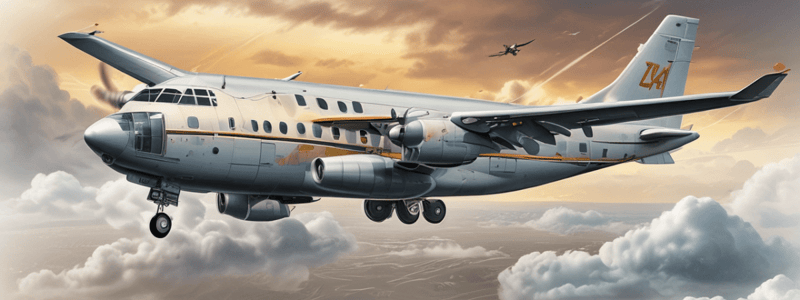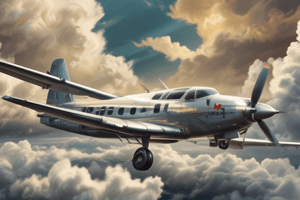Podcast
Questions and Answers
Which of the following is NOT a factor that pilots can determine from METARs and TAFs?
Which of the following is NOT a factor that pilots can determine from METARs and TAFs?
- Wind speed and direction
- Aircraft maintenance status (correct)
- Temperature
- Visibility
What kind of data do radar systems provide to pilots and flight dispatchers?
What kind of data do radar systems provide to pilots and flight dispatchers?
- Historical weather patterns and trends
- Real-time precipitation and storm movement data (correct)
- Real-time information on aircraft positions
- Detailed information about the composition of clouds
What is the primary advantage of satellite imagery over radar in terms of weather information?
What is the primary advantage of satellite imagery over radar in terms of weather information?
- Provides more precise data on wind speed and direction
- Offers a broader view of weather patterns and cloud formations (correct)
- Provides more accurate data on precipitation intensity
- Allows for real-time tracking of individual thunderstorms
Which of the following is NOT a source of Pilot Weather Reports (PIREPs)?
Which of the following is NOT a source of Pilot Weather Reports (PIREPs)?
How are PIREPs incorporated into the broader aviation weather network?
How are PIREPs incorporated into the broader aviation weather network?
Which of these is NOT a factor that might lead to in-flight adjustments based on weather information?
Which of these is NOT a factor that might lead to in-flight adjustments based on weather information?
What is the primary goal of the aviation weather network?
What is the primary goal of the aviation weather network?
What is the significance of understanding and using the information provided by the aviation weather network?
What is the significance of understanding and using the information provided by the aviation weather network?
Which of the following is NOT a key aspect of the aviation weather network?
Which of the following is NOT a key aspect of the aviation weather network?
What does the term 'en-route PIREPs' refer to?
What does the term 'en-route PIREPs' refer to?
The National Weather Service (NWS) is an international organization.
The National Weather Service (NWS) is an international organization.
METARs provide forecasts up to 30 hours ahead.
METARs provide forecasts up to 30 hours ahead.
The Federal Aviation Administration (FAA) is responsible for issuing METARs and TAFs.
The Federal Aviation Administration (FAA) is responsible for issuing METARs and TAFs.
The aviation weather network relies solely on government agencies for weather information.
The aviation weather network relies solely on government agencies for weather information.
TAFs provide near-real-time weather observations.
TAFs provide near-real-time weather observations.
The National Weather Service (NWS) works independently of other organizations to provide weather information.
The National Weather Service (NWS) works independently of other organizations to provide weather information.
METARs are only used for flight planning at departure airports.
METARs are only used for flight planning at departure airports.
The primary goal of the aviation weather network is to provide entertainment for pilots.
The primary goal of the aviation weather network is to provide entertainment for pilots.
TAFs are only issued for major airports.
TAFs are only issued for major airports.
Pilots can use METARs and TAFs to plan their route independently of other weather information sources.
Pilots can use METARs and TAFs to plan their route independently of other weather information sources.
How do pilots and flight dispatchers utilize radar and satellite technology to enhance flight safety?
How do pilots and flight dispatchers utilize radar and satellite technology to enhance flight safety?
What is the significance of Pilot Weather Reports (PIREPs) in the aviation weather network?
What is the significance of Pilot Weather Reports (PIREPs) in the aviation weather network?
How do updates to weather advisories, en-route PIREPs, and shifts detected in radar and satellite imagery impact in-flight decision making?
How do updates to weather advisories, en-route PIREPs, and shifts detected in radar and satellite imagery impact in-flight decision making?
What is the role of METARs and TAFs in the aviation weather network?
What is the role of METARs and TAFs in the aviation weather network?
How does the integration of weather information from various sources enhance pilot situational awareness?
How does the integration of weather information from various sources enhance pilot situational awareness?
What is the primary characteristic of the aviation weather network?
What is the primary characteristic of the aviation weather network?
How does the aviation weather network support pilots during pre-flight planning and in-flight operations?
How does the aviation weather network support pilots during pre-flight planning and in-flight operations?
What is the significance of understanding and effectively using the information provided by the aviation weather network?
What is the significance of understanding and effectively using the information provided by the aviation weather network?
How do Flight Service Stations (FSS), Air Route Traffic Control Centers (ARTCCs), and digital means contribute to the dissemination of PIREPs?
How do Flight Service Stations (FSS), Air Route Traffic Control Centers (ARTCCs), and digital means contribute to the dissemination of PIREPs?
What is the ultimate goal of the aviation weather network?
What is the ultimate goal of the aviation weather network?
Flashcards are hidden until you start studying
Study Notes
Weather Information Networks
- Comprise organizations like National Weather Service (NWS), Federal Aviation Administration (FAA), airlines, and weather data providers.
- Collect, analyze, and disseminate crucial weather data for aviation operations.
- Serve as the backbone for information exchange, impacting flight safety and decision-making.
Aviation Weather Reports
- METARs: Offer real-time weather conditions; crucial for assessing ambient conditions.
- TAFs: Provide weather forecasts specifically for airspace near airports, aiding in flight planning.
- These reports combine to create a comprehensive weather picture essential for pilots.
Importance of Radar Imagery
- Serves as a key tool for monitoring precipitation and storm movement.
- Radar data is integrated into weather information networks, ensuring pilots have access to critical information during planning and flights.
Pilot Reports (PIREPs)
- Real-time observations reported by pilots, detailing in-flight conditions like turbulence and icing.
- Enhance situational awareness and complement automated data, providing unique insights into actual weather experiences.
Collaboration Among Agencies
- NWS data aids the FAA in issuing NOTAMs (Notices to Airmen), highlighting potential hazards for pilots.
- Interconnectivity ensures a unified response to safety concerns and efficient communication among aviation stakeholders.
Real-Time Information Updates
- Advances in technology facilitate near real-time updates, crucial for decisions during rapidly changing weather conditions.
- Pilot's ability to adjust flight routes based on current data enhances safety and operational efficiency.
Weather Services During Flight Operations
- Weather services guide flight planning and execution, allowing pilots to make informed decisions.
- Utilizing collected data effectively supports timely actions like diversions or cancellations due to unfavorable weather.
Tools and Resources for Pilots
- Weather service resources include satellite links, online portals, and in-cockpit displays.
- Pilots must master both the access to and interpretation of these tools to ensure safety and optimal flight operations.
Continuous Assessment of Weather Data
- Flight planning incorporates updates from weather advisories, PIREPs, radar, and satellite images.
- Ongoing evaluation allows pilots to make necessary adjustments en route to maintain safety and comfort.
Future of Aviation Weather Technology
- Emerging technologies like automated systems and data-fusion algorithms are set to enhance pilot interactions with weather data.
- Staying updated on technological advancements is important for future pilots to improve operational efficiency and safety.
Key Takeaway
- Mastery of weather information networks and their products (METARs, TAFs, radar, PIREPs) is essential for informed decision-making, optimizing flight safety and operational planning in the aviation industry.
Weather Information Networks
- Weather Information Networks consist of collaborative organizations like the National Weather Service (NWS), Federal Aviation Administration (FAA), airlines, and private weather data providers.
- These networks are essential for gathering, analyzing, and distributing critical weather data to support flight planning and safety.
METARs and TAFs
- METARs (Aviation Routine Weather Reports) provide current weather conditions, crucial for immediate flight considerations.
- TAFs (Terminal Aerodrome Forecasts) deliver weather forecasts for up to 30 hours ahead, helping pilots anticipate conditions at departure and destination airports.
- Combining METARs and TAFs creates a comprehensive weather picture for pilots.
Importance of Radar Imagery
- Radar imagery is vital for assessing precipitation and storm movement, aiding pilots in avoiding adverse weather.
- Weather information networks ensure that radar data is accessible to pilots and flight planners in real-time.
Pilot Reports (PIREPs)
- PIREPs offer subjective observations from pilots during flight, reporting in-flight conditions such as turbulence and icing.
- These real-time reports complement automated weather data and enhance situational awareness for pilots.
Collaboration in Weather Services
- The relationship between organizations, such as NWS providing data for FAA-issued NOTAMs (Notices to Airmen), illustrates interconnectivity within the weather information network.
- This collaboration enhances safety by ensuring pilots are informed about potential hazards along their flight route.
Real-Time Data Distribution
- Advancements in technology enable near real-time updates, allowing pilots to make informed decisions quickly in rapidly changing weather conditions.
- Complex weather systems can be communicated effectively across distances, like a pilot in Miami receiving briefings based on conditions in Seattle.
Impact on Flight Planning and Safety
- Timely, consolidated information from weather networks allows pilots to make vital decisions such as delaying, rerouting, or canceling flights to mitigate risks.
- The integration of weather information into flight planning is essential for maintaining safety and efficiency in aviation operations.
Evolution of Weather Services
- New technology, including automated systems and data-fusing algorithms, is transforming how pilots gather and interpret weather data.
- Mastering access to and interpretation of weather products is essential for aspiring commercial pilots.
Summary of Weather Services
- Understanding METARs, TAFs, radar images, and PIREPs is crucial for strategic flight operations, influencing decisions before and during flights.
- The next focus will be on exploring the overarching weather information networks that support these aviation weather services.
Overview of Weather Information Networks in Aviation
- Weather information networks are essential for aviation, providing crucial data for pilots and enhancing flight safety.
- Collaboration among organizations like the National Weather Service (NWS), Federal Aviation Administration (FAA), airlines, and weather data providers is fundamental to these networks.
Key Weather Reporting Tools
- METARs (Aviation Routine Weather Reports): Deliver current weather conditions; near real-time data is critical for immediate flight considerations.
- TAFs (Terminal Aerodrome Forecasts): Provide weather forecasts up to 30 hours ahead, helping pilots anticipate conditions at their destination and alternate airports.
- Both METARs and TAFs contribute to pilots' understanding of visibility, wind speed, cloud cover, and temperature, influencing flight routing and planning.
Radar and Satellite Technology
- Radar systems, managed by organizations like NOAA, supply real-time data on precipitation and storm movement, essential for avoiding adverse weather.
- Satellite imagery offers a wider perspective on weather patterns, enhancing situational awareness for flight planning and execution.
Pilot Reports (PIREPs)
- PIREPs are subjective, real-time reports from pilots in-flight, documenting conditions such as turbulence, icing, and visibility.
- Collected and disseminated by Flight Service Stations (FSS) and Air Route Traffic Control Centers (ARTCCs), PIREPs enrich weather briefings and situational awareness.
Decision-Making and Safety Implications
- Timely weather updates allow pilots to make informed decisions during flight, which is crucial with rapidly changing weather conditions.
- Comprehensive weather data from networks enables pilots to adjust flight plans, such as delaying or rerouting, to enhance safety and efficiency.
Interconnectedness of Weather Services
- The relationship between organizations like the NWS and FAA exemplifies collaboration, as NWS data informs FAA-issued NOTAMs for pilots regarding potential hazards.
- Updates from weather information networks are distributed in near real-time, ensuring pilots can act quickly on the latest conditions.
Importance of Continuous Assessment
- Weather information is continuously evaluated not just pre-flight but also during the flight, allowing for real-time adjustments to flight plans for safety and comfort.
- The integration of radar, satellite data, and PIREPs is vital for maintaining situational awareness throughout the duration of a flight.
The Future of Weather Information Networks
- Understanding and effectively utilizing data from weather information networks will aid pilots in making informed decisions and enhance overall flight safety.
- Continued exploration of technology and products available to pilots will further improve flight operations and safety standards in aviation.
Studying That Suits You
Use AI to generate personalized quizzes and flashcards to suit your learning preferences.




